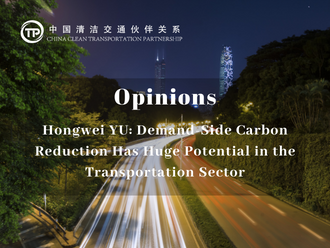
Xiaoshi LIU, Deputy Secretary-General of China EV 100, believes that China's automotive industry will remain in the era of power diversification technology paths for a long time and thus requires adjustments in its energy infrastructure construction planning. Key nodes such as oil-to-electricity and gas-to-electricity conversions need to be prioritized to support the development of the industry.
More
In the view of Danyang YU, Associate Researcher at the Science and Information Center of the Transportation Research Institute of the Ministry of Transport, the national transportation carbon emissions accounting scope is mainly based on transportation vehicles, with the accounting basis including both commercial and non-commercial aspects. She suggests that national, industry, and local accounting results should be consistent. They should also accurately understanding the differences between national macro accounting, enterprise micro accounting, and regional accounting.
More
Xiaoyi LI, engineer from the Planning and Research Institute of the Ministry of Transport, pointed out that the main difference between the IPCC and the greenhouse gas accounting boundaries in the Chinese transportation sector is whether international aviation and shipping are included. She also mentioned that non-commercial vehicles and accounting boundaries are the difficulties and key points in the practice of local carbon emissions accounting. She suggested that a unified carbon emission accounting method system should be formulated at the national level as soon as possible, and a cross-departmental carbon emission basic database should be established.
More
Shu CHEN, chief engineer at the Urban Transportation Research Institute/Intelligent Research Institute of the Urban Transportation Planning and Design Institute of Shenzhen, has proposed the following strategy suggestions for Shenzhen's transportation emission reduction: vigorously develop clean transportation energy, promote the low-carbon transformation of freight vehicles, increase the proportion of rail and waterway transportation, enhance the attractiveness of green travel, encourage green travel, advocate for a "voluntary + mandatory" carbon reduction model through flexible interactions, improve traffic congestion, and maintain low-carbon transportation operating speeds, among others.
More
Hongwei YU, associate professor at the Wuhan University Carbon Neutrality Research Center and the Institute of Quality Development Strategy, believes that demand-side carbon reduction has huge potential in the transportation sector. At the same time, he suggests that in addition to reducing emissions from production, mechanisms for reducing emissions on the consumption side should be introduced in a timely manner to help achieve carbon neutrality goals.
More
Shu CHEN, chief engineer at the Urban Transportation Research Institute/Intelligent Research Institute of the Urban Transportation Planning and Design Institute of Shenzhen, pointed out the following challenges faced by Shenzhen in promoting transportation carbon reduction: carbon emissions in the transportation sector have become the most significant terminal source of carbon emissions in Shenzhen; the future demand for transportation in Shenzhen is still facing growth; and top-down approaches are insufficient to support the demand for fine-scale transportation carbon emission data.
More
Hong TIAN, director of the Chengdu Motor Vehicle Exhaust Pollution Prevention and Control Technology Guarantee Center, believes that the annual inspection data of urban motor vehicles is an effective tool to support data mining for environmental monitoring of automobiles. At the same time, in the context of "dual carbon", it is very important to analyze the characteristics of CO2 emissions.
More
Dr. Miao LING, a researcher at the School of Intelligent Engineering at Sun Yat-sen University, emphasized that the simulation of future emissions and synergy analysis is a key step to achieve peak carbon emissions and cooperative control. He also conducted a cost-effectiveness analysis of reducing emissions in road traffic in the Pearl River Delta region, and pointed out that the long-term planning of a city should prioritize long-term policies such as improving emission standards and prioritizing public transportation policies.
More
Huiming GONG, senior program director of the Transportation Program at the Energy Foundation, emphasized that the concept of "next-generation infrastructure" should not be confused with that of "new infrastructure," as there are fundamental differences between the two. Gong noted that the push towards electrifying medium and heavy-duty vehicles imposes greater demands on infrastructure.
More
According to Huiming GONG, Senior Project Director of Transportation at the Energy Foundation, under the backdrop of the dual-carbon goal, carbon emissions from freight transportation are expected to peak or reach a plateau before 2030. However, there is great uncertainty regarding carbon neutrality in freight transportation, which requires further in-depth and systematic research.
MoreCCTP is a non-governmental, non-profit, and voluntary platform, focusing on policy and technological innovations, summarizing and disseminating national and global practices for a net-zero transportation sector.